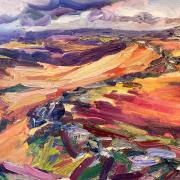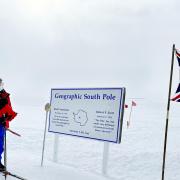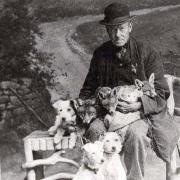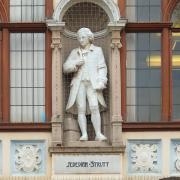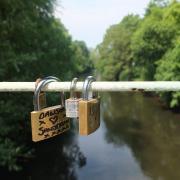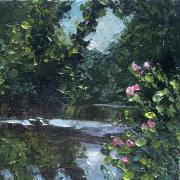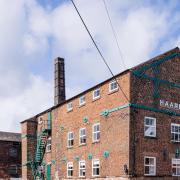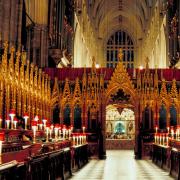Experienced writer Garry Martin has worked as a teacher, documented a sailing trip that took him halfway around the world, followed many years later by a much riskier adventure in a war-torn land, travelled to India to research a book, been a restaurateur and the owner of a bookshop...

Speaking on BBC Radio Nottingham, the top-selling author Robert Macfarlane, hailed by William Dalrymple as ‘the formidable new champion of British landscape writers’, said: ‘Every so often you meet a teacher who changes your life. Garry Martin was that person for me.’
Some of the other top writers who are indebted to Garry’s inspirational teaching include the prize-winning novelist Jonathan Coe and the well-known journalists Andrew Billen and Mark Steyn. As well as nurturing literary talent, Garry has produced several highly original literary efforts of his own, including the novelette Beneath Napoleon’s Hat, published recently by Colley Books.
When I met Garry at the cottage in Stanton-in-Peak which he shares with his partner, the artist Sue Lewis-Blake, I discovered that there are far more aspects to his life than teaching and writing. These include a much-publicised adventure at sea, followed many years later by a much riskier adventure in a war-torn land. He has travelled to India to research a book, been a restaurateur and the owner of a bookshop. It would be hard to find a more impressive and varied curriculum vitae.
Garry was born in Burton upon Trent in 1948 and was educated at the local grammar school. At the age of nine, he was awarded a scholarship by Burton Art College, which enabled him to attend life-drawing classes when he reached his teens, making him the envy of his friends. He furthered his education at Emmanuel College, Cambridge, where he read English. After graduating, he worked as a systems analyst.

Explaining this unlikely career choice, Garry said: ‘I would have liked to pursue a much less financially secure career as a writer, but I had always thought that I had an obligation to make a ‘proper’ living. Luckily, the need to write reports detailing every stage of each of the projects I was asked to undertake made almost as much use of my writing skills as a literary career would have done.’
Nevertheless, after three years in the job, Garry decided to apply for a traineeship with the BBC. The corporation gave him a deferred place on the understanding that he would first gain some experience as a journalist. Garry acquired this experience in a very novel and exciting way.
After obtaining sponsorship from the Levi’s Jeans company, which was keen to promote a new range of jeans for women, Garry and one of his friends set off with their new brides on a long sea voyage on a yacht called Miss Levi’s. Garry persuaded the producers of Women’s Hour to allow him to broadcast a series of reports from the yacht about the progress of the ‘Honeymoon Cruise’ and he negotiated a deal to write regular articles about the voyage for Yachting and Boating Weekly.
On his return from the two-year adventure on the high seas that had taken him half way around the world, Garry decided not to begin his traineeship with the BBC, opting instead for a post as a teacher at Brentwood School, an independent school in Essex. Garry said, ‘I chose English teaching, not only because I love literature, but also because I felt that the job might give me sufficient time to complete a novel I had started.’

Entitled To Weave a Rainbow, the novel was eventually published by Malvern Publishing, an imprint designed to bring new writers to the marketplace. The book describes a youthful liaison between a boy and a girl who meet by chance during a sightseeing trip to London.
Even though Garry had hoped that the publication of his novel might lead to a life of writing, he knew that he would still need to maintain a steady income. After four years at Brentwood, he took up a post at King Edward’s School, Birmingham, where he was responsible for tutoring pupils aiming for Oxbridge entry. It was here that he taught Jonathan Coe who would go on to write many well-received novels, including The Rotters’ Club, a novel based on his experiences at the school.
In 1980, Garry gave up teaching to embark on the first of two business ventures. The first enterprise was in Coleshill, where he and his wife opened Blythes Restaurant, an eatery that quickly built up a great reputation and gained a coveted Michelin listing. The second was in Knowle, where he founded an independent bookshop that doubled as an art gallery.
After these two forays into business, Garry returned to teaching and writing, taking up a job as a writer-in-residence at Cranleigh School in Surrey. But these were turbulent times for him, not only because he was undergoing a divorce, but also because he had accepted a request from a friend to help in a mission to Kurdish Iraq in the immediate aftermath of the first Gulf War. He narrowly escaped capture whilst he was there, but managed to file dispatches for the BBC World Service and to write A Sane Asylum, a novel based on his journal of the trip.
The remainder of Garry’s teaching career was spent at Nottingham High School, where he ‘enjoyed encouraging and challenging very bright pupils’, one of whom was Robert Macfarlane, who has remained a good friend. Five years into his time at the school, he was given an extended summer break in order to go to India where he intended to research a book about Avatars. In fact, he returned with the germ of a story to be called The Boy Who Made God Smile.
For twelve years, Garry maintained a bolt hole in Middleton-by-Wirksworth, where he began work to bring this and several other literary projects to fruition. Since retiring from teaching and relocating with his partner to Stanton-in-Peak, he has been able to put all his creative energy into writing.
The first publication to emerge since his retirement is Beneath Napoleon’s Hat, the initial volume in a trilogy of novelettes based around the café society of Paris in the twenties and thirties. Explaining the title, Garry said, ‘During trips to Paris, I often visit the Café Procope, where I sit beneath a glass case containing Napoleon’s hat, which had been left by the future Emperor when he was a young officer. Intended as security for an unpaid bill, it was never reclaimed. Once installed beneath the hat, I open my notebook and begin to scribble stories about the people who frequented the cafés.’
Garry’s book is a series of imagined exchanges involving the writer and publisher Robert McAlmon, his wife Bryher, who is said to have married him to escape her father’s tyranny, and Bryher’s lesbian lover Hilda Doolittle. Several members of their literary circle, including Havelock Ellis and Ronald Firbank, add their own wit to the conversations. When Ellis is asked by Bryher if she is ‘impossible’, he replies: ‘No. You’re just improbable.’ Refuting suggestions of loneliness, Firbank says: ‘I am never lonely because my hands are so beautiful. I love to sit before a mirror and watch their gestures.’
These amusing exchanges and the other fictitious conversations described in the book are fascinating and very engaging. Robert Macfarlane, the writer whose life was changed by Garry, has described his former teacher’s novelette as a work that is ‘full of vim and vigour and repartee’. w
Beneath Napoleon’s Hat: Tales from the Parisian Cafés (Volume 1: Eagles without a Cliff) by GJ Martin is published by Colley Books and priced at £9.95.






